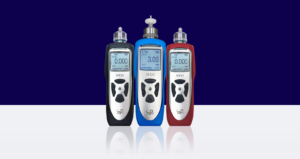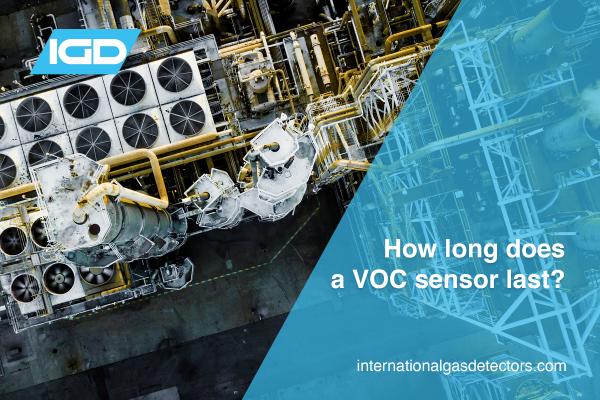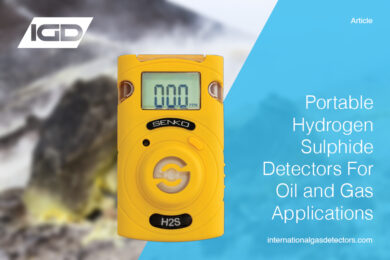How long does a VOC sensor last? VOC sensors based on Photo-Ionisation technology (PID) are more complex than most other types of gas detector. PID based detectors utilise an Ultra-violet (UV) lamp to ionise the gas sample. The life of the UV lamp is one of the on-going costs of ownership for this type of detector. This article delves into the typical lamp life currently on the market and why it is capped at a certain amount. IGDs specialist knowledge in PID detection however allows us to set the standard with our revolutionary new development in VOC sensor technology. Read below to find out more about this latest improvement.
What is the Typical VOC Sensor Life and Why?
The current industry standard for UV lamp life in a PID based VOC sensor is currently 10,000 hours (just over a year). This is common across the industry due to the technology used in PIDs when detecting VOCs. Photoionisation detectors (PIDs) contain a UV lamp, which is used to ionise gas molecules passing through the detector. The charge of these ionised gas molecules is then measured as they pass through an electron capture grid within the detector. The measured charge is proportional to the target gasses and can be equated to a PPM or PPB gas level reading.
There are various lamp ‘options’ that can be fitted to a PID based VOC detector. Commonly the lamp is filled with Krypton (Kr), a noble gas which when energised will ionise gasses with an ionisation potential up to and including 10.6eV (electron volts). Please see below our video that demonstrates how a PID sensor works.
There are two other common lamp options, 9.6eV and 11.7eV. By correct choice of lamp, you can include or exclude particular gas types. However, lamp construction and the gas fill can work to limit lamp life. For example, some gas types need the 11.7eV lamp in order to work due to them having a higher ionisation potential. The downside is that 11.7 eV lamps have a very short life (weeks). This may be OK in a portable detector used for a few hours at a time but cannot really be used in a fixed system. By far the most common lamp is the 10.6eV, the 9.6eV lamp being generally used to aid Benzene detection by excluding as many other gases as possible. In this application an active filter cartridge is also employed to make the detector Benzene specific. Lamps need cleaning as part of normal maintenance and the electron capture grid, or electrode stack many need periodic replacement if it gets contaminated. Regular calibration is also a requirement for VOC sensors.
Lamp Life Limitations
One of the main limitations can be lamp life. This is mainly down to the construction of the lamp. In order to energise the gas inside the lamp to generate Ultraviolet light, energy needs to be pumped into the gas. The most common method to do this is to include a metal ring inside the lamp. This inductively couples with the drive circuit to get energy into the gas. The problem with this method is an effect called sputtering. This happens as the surface of the metal ring vaporises and then slowly coats the inside of the lamp reducing its efficiency.
VOC Sensors with IGD
IGDs latest development in PID technology allows us to introduce a new standard of VOC detection. We have been able to increase the lamp life in the fixed VOC sensor by 50%, enabling us to offer a 15,000-hour lamp life. This revolutionary step forward in PID technology means we offer the longest lamp life currently available on the market. With this we are truly able to demonstrate our century of experience and specialised knowledge in PID detection.
How do we do this?
Unlike inductively coupled PID lamps which suffer from sputtering, IGD’s PID’s use RF technology. Here the RF field excites the gas directly to generate UV light. As there is no metal ring inside the lamp there is no sputtering effect resulting in longer lamp life.
We can offer this outstanding VOC sensor on our Sentinel+ 2-Wire addressable technology, in ATEX, safe area or sampling devices. With our 2-Wire Addressable technology, costs of installation are reduced by 70%, with the additions of a significant reduction in cabling and easy integration into an existing BMS system.
In addition, unlike current PID sensors available on the market, our TOC-750 series detectors provide clients with true, real time digital data. This is crucial for when detecting VOC gases as you need the reliability, accuracy and digital data to ensure personnel are not being over exposed to these toxic and carcinogenic gases. This ensures clients are not surprised by any additional costs before and after purchase and can download event reports via the secure on board wifi pages. We also support our clients with a 10-year warranty on our products and free owner operator training to understand more about PID sensors. All of this is so you can be sure that you have a competent, high quality and detectably better VOC sensor straight from the manufacturer.
Portable PID Detectors
IGD can now also offer the complete VOC sensor solution with our additions of the portable POLI and NEO to our product range from mPower. These new additions allow us to offer the most stable PPB level in any portable PID currently on the market. Both the POLI and the NEO are protected by a durable outer housing, thus are ideal for any environment. mPower VOC sensors feature plug and plus smart sensors, for easily traceable calibration data.

Contact Our Team of PID Experts
From detectably better products to the highest quality, expertise guidance and knowledge, IGD offer the full detection solution to all our clients. To find out more about our VOC sensors, contact our team today.




